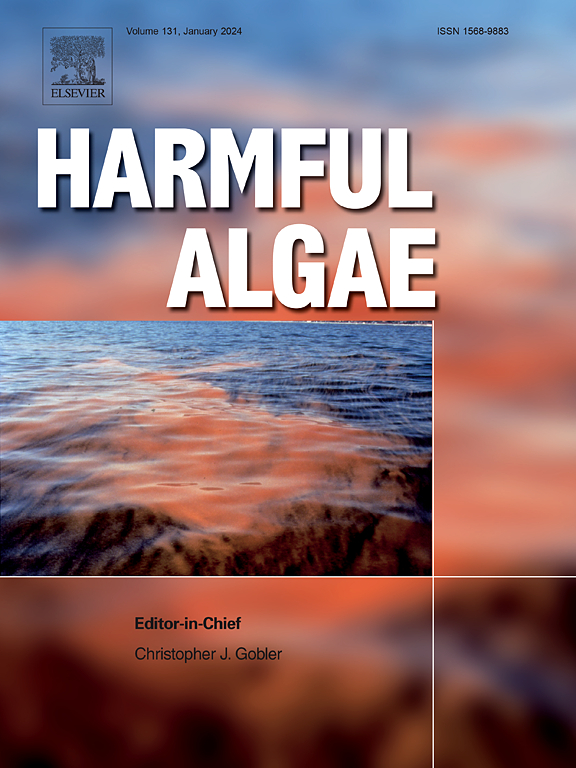Comparative genomic and phylogenetic analysis of mitochondrial genomes of the Pseudo-nitzschia HAB species
IF 5.5
1区 生物学
Q1 MARINE & FRESHWATER BIOLOGY
引用次数: 0
Abstract
The genus Pseudo-nitzschia within Bacillariophyta (diatoms) is best known for its rich collection of toxigenic harmful algal bloom (HAB) species capable of producing the neurotoxin domoic acid (DA), which causes amnesic shellfish poisoning (ASP) in humans. Molecular markers such as 18S rDNA, ITS1, and ITS2 have been applied to facilitate Pseudo-nitzschia species identification because morphology-based methods often could not adequately distinguish different species due to their morphological similarities and plasticity. In this study, we constructed mitochondrial genomes (mtDNAs) for 11 Pseudo-nitzschia species and assessed their utility as “super-barcodes” for species identification and evolutionary analysis. These mtDNAs exhibited conserved genome structures despite variability in repeat regions. A potential tatA-tatC gene fusion event was observed in a single Pseudo-nitzschia species P. brasiliana. We also observed intron variability in cox1 genes. Phylogenetic analyses of mtDNAs, chloroplast genomes (cpDNAs), and nuclear ribosomal DNA (nrDNA) arrays revealed consistent results, supporting the closely related but distinct clustering of the genera Fragilariopsis and Pseudo-nitzschia. We further designed a high-resolution molecular marker tatA for species identification based on the comparative analysis of these mtDNAs, which could be used to track Pseudo-nitzschia diversity. These findings offer new genome resources and new insights into the genetic evolution and classification of Pseudo-nitzschia, underscoring the need for continued research in this field.
伪尼茨氏菌HAB种线粒体基因组的比较基因组学和系统发育分析
硅藻门(硅藻)中的伪nitzschia属以其丰富的产毒有害藻华(HAB)物种而闻名,这些物种能够产生神经毒素软骨藻酸(DA),从而导致人类失忆性贝类中毒(ASP)。分子标记如18S rDNA、ITS1和ITS2已被应用于伪nitzschia的物种鉴定,因为基于形态的方法往往不能充分区分不同的物种,因为它们的形态相似性和可塑性。在这项研究中,我们构建了11种伪nitzschia的线粒体基因组(mtdna),并评估了它们作为物种鉴定和进化分析的“超级条形码”的实用性。这些mtdna表现出保守的基因组结构,尽管重复区域存在差异。在一种巴西拟尼契亚虫中观察到潜在的tatA-tatC基因融合事件。我们还观察到cox1基因中的内含子变异。mtdna、叶绿体基因组(cpdna)和核糖体DNA (nrDNA)阵列的系统发育分析结果一致,支持Fragilariopsis和pseudonitzschia属密切相关但不同的聚类。在比较分析这些mtdna的基础上,我们进一步设计了一种高分辨率的分子标记tatA,用于物种鉴定,可用于跟踪伪尼茨奇亚的多样性。这些发现为伪nitzschia的遗传进化和分类提供了新的基因组资源和新的见解,强调了该领域继续研究的必要性。
本文章由计算机程序翻译,如有差异,请以英文原文为准。
求助全文
约1分钟内获得全文
求助全文
来源期刊

Harmful Algae
生物-海洋与淡水生物学
CiteScore
12.50
自引率
15.20%
发文量
122
审稿时长
7.5 months
期刊介绍:
This journal provides a forum to promote knowledge of harmful microalgae and macroalgae, including cyanobacteria, as well as monitoring, management and control of these organisms.
 求助内容:
求助内容: 应助结果提醒方式:
应助结果提醒方式:


